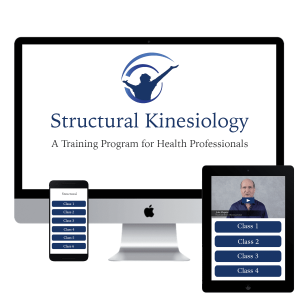What’s in the Structural Kinesiology Module
This program gives you in-depth understanding and skill in working with the physical body.
It includes online recorded video training on specific techniques and protocols that you can watch as many times as you like at your own pace.
You’ll understand how to assess and correct structural and functional imbalances to bring the body back into postural alignment. This results in freedom from pain and improved range of motion.
It is particularly helpful for those working with athletes, and dancers to help them achieve peak performance.
You’ll know how to assess and correct a wide variety of common conditions to get profound and often immediate results.
What You Will Learn
- How to test the major muscles of the body – along with each muscle’s location, function, associated organ and meridian, indications of dysfunction and signs of postural imbalance
- Injury Recall Technique – probably the most important correction you can do for someone that clears the neurological memory of an injury to restore energy flow and range of motion and help prevent future injuries.
- Lymphatic Drainage techniques – to restore proper lymphatic flow and help rid the body of toxins
- Hidden Muscle Failure – to uncover imbalances not detected with normal testing
- Aerobic muscle testing – how to find challenges that occur with sustained muscle use
- Myofascial Release – how to test and correct tightness in the fascial plains
- Gait Reflexes – How to test and correct factors that can affect walking and running, particularly helpful in athletes
- Ileocecal Valve & Valves of Houston – ways to find and correct these important structures in the digestive tract to help clear up a myriad of health challenges
- Dural Torque Correction – A simple technique to balance the sheath around the spinal cord than can help clear headaches, back pain and neck pain
- General Adrenal – Ligaments – A condition that weakens ligaments throughout the body related to adrenal stress.
- Ligament Reset – how to reset proprioceptors in the joint ligaments that are offset in sprains to improve the strength and flexibility of joints
- Hiatal Hernia – how to balance the factors that can cause this common condition, which helps acid reflux and other digestive problems
- Intercostal Reset Technique – a technique that can improve breathing capacity and breath holding time, which nearly everyone can benefit from
- TMJ – how to balance the single most important joint in the body that can help correct many other imbalances, such as headaches, back pain and emotional conditions
- Cranials – how to access and balance the cranial bones to
- Pitch Roll & Yaw – a condition that can affect performance and result in neurological switching
- Pelvic Categories – misalignment of the pelvis and lower back that can result in back and hip pain
- Contralateral Joint Interlink – a method to correct pain in a joint by working on the contralateral one
- Scar Clearing Techniques – how to clear the neural factors that can affect meridian energy flow
- Retrograde Lymphatic – a key technique that can enhance the body’s sewer system and help a wide variety of conditions, including edema, joint problems and respiratory conditions
- Reactive Muscles – resetting the neurological factors within the muscles
- PNF Stretching – a method to increase flexibility and range of motion
- Balancing According to Posture – how to look at someone’s posture and immediately know which muscles are out of balance


You must be <a href="https://wislibrary.net/my-account/">logged in</a> to post a review.